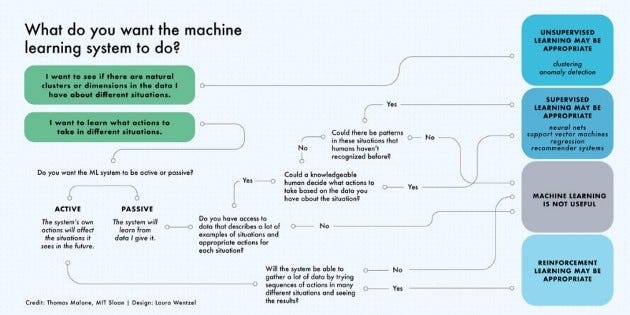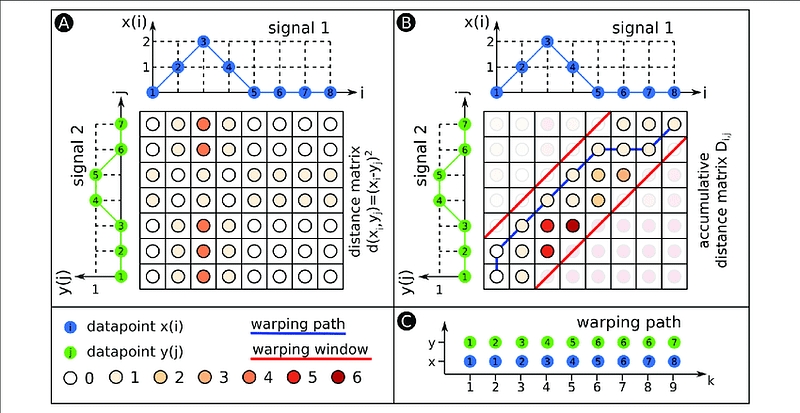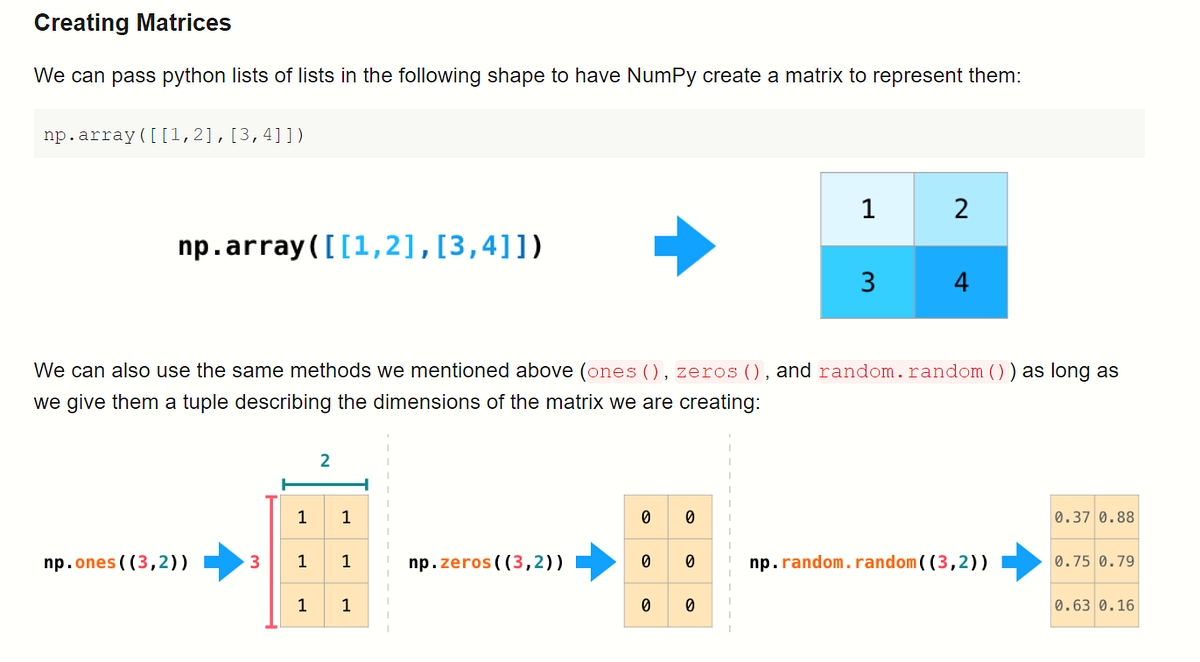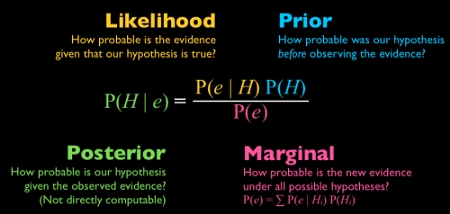Machine Learner
This list of resources is specifically targeted at Web Developers and Data Scientists…. so do with it what you will…This list borrows…
Everything You Need To Become A Machine Learner
This list of resources is specifically targeted at Web Developers and Data Scientists…. so do with it what you will…This list borrows heavily from multiple lists created by : sindresorhus
 Machine learning is a subfield of artificial intelligence, which is broadly defined as the capability of a machine to imitate intelligent human behavior. Artificial intelligence systems are used to perform complex tasks in a way that is similar to how humans solve problems.
Machine learning is a subfield of artificial intelligence, which is broadly defined as the capability of a machine to imitate intelligent human behavior. Artificial intelligence systems are used to perform complex tasks in a way that is similar to how humans solve problems.
The goal of AI is to create computer models that exhibit “intelligent behaviors” like humans, according to Boris Katz, a principal research scientist and head of the InfoLab Group at CSAIL. This means machines that can recognize a visual scene, understand a text written in natural language, or perform an action in the physical world.
Machine learning is one way to use AI. It was defined in the 1950s by AI pioneer Arthur Samuel as “the field of study that gives computers the ability to learn without explicitly being programmed.”
 - \[📖\] Delivering Happiness - \[📖\] Good to Great: Why Some Companies Make the Leap…And Others Don’t - \[📖\] Hello, Startup: A Programmer’s Guide to Building Products, Technologies, and Teams - \[📖\] How Google Works - \[📖\] Learn to Earn: A Beginner’s Guide to the Basics of Investing and Business - \[📖\] Rework - \[📖\] The Airbnb Story - \[📖\] The Personal MBA - \[ \] Facebook: Digital marketing: get started - \[ \] Facebook: Digital marketing: go further - \[ \] Google Analytics for Beginners - \[ \] Moz: The Beginner’s Guide to SEO - \[ \] Smartly: Marketing Fundamentals - \[ \] Treehouse: SEO Basics - \[🅤\]ꭏ App Monetization - \[🅤\]ꭏ App Marketing - \[🅤\]ꭏ How to Build a Startup
- \[📖\] Delivering Happiness - \[📖\] Good to Great: Why Some Companies Make the Leap…And Others Don’t - \[📖\] Hello, Startup: A Programmer’s Guide to Building Products, Technologies, and Teams - \[📖\] How Google Works - \[📖\] Learn to Earn: A Beginner’s Guide to the Basics of Investing and Business - \[📖\] Rework - \[📖\] The Airbnb Story - \[📖\] The Personal MBA - \[ \] Facebook: Digital marketing: get started - \[ \] Facebook: Digital marketing: go further - \[ \] Google Analytics for Beginners - \[ \] Moz: The Beginner’s Guide to SEO - \[ \] Smartly: Marketing Fundamentals - \[ \] Treehouse: SEO Basics - \[🅤\]ꭏ App Monetization - \[🅤\]ꭏ App Marketing - \[🅤\]ꭏ How to Build a Startup
Natural language processing
Natural language processing is a field of machine learning in which machines learn to understand natural language as spoken and written by humans, instead of the data and numbers normally used to program computers. This allows machines to recognize language, understand it, and respond to it, as well as create new text and translate between languages. Natural language processing enables familiar technology like chatbots and digital assistants like Siri or Alexa.
 ### Neural networks
### Neural networksNeural networks are a commonly used, specific class of machine learning algorithms. Artificial neural networks are modeled on the human brain, in which thousands or millions of processing nodes are interconnected and organized into layers.
In an artificial neural network, cells, or nodes, are connected, with each cell processing inputs and producing an output that is sent to other neurons. Labeled data moves through the nodes, or cells, with each cell performing a different function. In a neural network trained to identify whether a picture contains a cat or not, the different nodes would assess the information and arrive at an output that indicates whether a picture features a cat.
Be familiar with how Machine Learning is applied at other companies
[📺 ] How does YouTube recommend videos? — AI EXPLAINED!
0:33:53[📺 ] How does Google Translate’s AI work?
0:15:02[📺 ] Data Science in Finance
0:17:52[📺 ] The Age of AI
[ ] How Far is Too Far? | The Age of A.I.
0:34:39[ ] Healed through A.I. | The Age of A.I.
0:39:55[ ] Love, art and stories: decoded | The Age of A.I.
0:38:57[ ] The ‘Space Architects’ of Mars | The Age of A.I.
0:30:10[ ] Will a robot take my job? | The Age of A.I.
0:36:14[📺 ] Machine learning across industries with Vicki Boykis
0:34:02[📺 ] Rachael Tatman — Conversational A.I. and Linguistics
0:36:51
Be able to frame anMachine Learning problem
· [ ] AWS: Types of Machine Learning Solutions
· [📰] Apply Machine Learning to your Business
· [📰] Resilience and Vibrancy: The 2020 Data & AI Landscape
· [📰] Software 2.0
· [📰] Highlights from ICML 2020
· [📰] A Peek at Trends in Machine Learning
· [📰] How to deliver on Machine Learning projects
· [📰] Data Science as a Product
· [📰] Customer service is full of machine learning problems
· [📰] Choosing Problems in Data Science and Machine Learning
· [📰] Why finance is deploying natural language processing
· [📰] The Last 5 Years In Deep Learning
· [📰] Always start with a stupid model, no exceptions.
· [📰] Most impactful AI trends of 2018: the rise ofMachine Learning Engineering
· [📰] Building machine learning products: a problem well-defined is a problem half-solved.
· [📰] Simple considerations for simple people building fancy neural networks
· [📰] Maximizing Business Impact with Machine Learning
· [📖] AI Superpowers: China, Silicon Valley, and the New World Order
· [📖] A Human’s Guide to Machine Intelligence
· [📖] The Future Computed
· [📖] Machine Learning Yearning by Andrew Ng
· [📖] Prediction Machines: The Simple Economics of Artificial Intelligence
· [📖] Building Machine Learning Powered Applications: Going from Idea to Product
· [ ] Coursera: AI For Everyone
· [💻] Data Science for Everyone
· [💻] Machine Learning with the Experts: School Budgets
· [💻] Machine Learning for Everyone
· [💻] Data Science for Managers
· [ ] Facebook: Field Guide to Machine Learning
· [G] Introduction to Machine Learning Problem Framing
· [ ] Pluralsight: How to Think About Machine Learning Algorithms
· [ ] State of AI Report 2020
· [📺 ] Vincent Warmerdam: The profession of solving (the wrong problem) | PyData Amsterdam 2019
· [📺 ] Hugging Face, Transformers | NLP Research and Open Source | Interview with Julien Chaumond
· [📺 ] Vincent Warmerdam — Playing by the Rules-Based-Systems | PyData Eindhoven 2020
· [📺 ] Building intuitions before building models
Be familiar with data ethics
[📺 ] SE4AI: Ethics and Fairness 1:18:37
[📺 ] SE4AI: Security 1:18:24
[📺 ] SE4AI: Safety 1:17:37
Be able to import data from multiple sources
Be able to setup data annotation efficiently
[📰] Create A Synthetic Image Dataset — The “What”, The “Why” and The “How”
[📺 ] SE4AI: Data Quality 1:07:15
[📺 ] SE4AI: Managing and Processing Large Datasets 1:21:27
Be able to manipulate data with Numpy

Be able to manipulate data with Pandas
 - **\[📰\]** Visualizing Pandas’ Pivoting and Reshaping Functions - **\[📰\]** A Gentle Visual Intro to Data Analysis in Python Using Pandas - **\[📰\]** Comprehensive Guide to Grouping and Aggregating with Pandas - **\[📰\]** 8 Python Pandas Value_counts() tricks that make your work more efficient - **\[💻\]** pandas Foundations - **\[💻\]** Pandas Joins for Spreadsheet Users - **\[💻\]** Manipulating DataFrames with pandas - **\[💻\]** Merging DataFrames with pandas - **\[💻\]** Data Manipulation with pandas - **\[💻\]** Optimizing Python Code with pandas - **\[💻\]** Streamlined Data Ingestion with pandas - **\[💻\]** Analyzing Marketing Campaigns with pandas - **\[ \]** edX: Implementing Predictive Analytics with Spark in Azure HDInsight - **\[📰\]** Modern Pandas - **\[ \]** Modern Pandas (Part 1) - **\[ \]** Modern Pandas (Part 2) - **\[ \]** Modern Pandas (Part 3) - **\[ \]** Modern Pandas (Part 4) - **\[ \]** Modern Pandas (Part 5) - **\[ \]** Modern Pandas (Part 6) - **\[ \]** Modern Pandas (Part 7) - **\[ \]** Modern Pandas (Part 8)
- **\[📰\]** Visualizing Pandas’ Pivoting and Reshaping Functions - **\[📰\]** A Gentle Visual Intro to Data Analysis in Python Using Pandas - **\[📰\]** Comprehensive Guide to Grouping and Aggregating with Pandas - **\[📰\]** 8 Python Pandas Value_counts() tricks that make your work more efficient - **\[💻\]** pandas Foundations - **\[💻\]** Pandas Joins for Spreadsheet Users - **\[💻\]** Manipulating DataFrames with pandas - **\[💻\]** Merging DataFrames with pandas - **\[💻\]** Data Manipulation with pandas - **\[💻\]** Optimizing Python Code with pandas - **\[💻\]** Streamlined Data Ingestion with pandas - **\[💻\]** Analyzing Marketing Campaigns with pandas - **\[ \]** edX: Implementing Predictive Analytics with Spark in Azure HDInsight - **\[📰\]** Modern Pandas - **\[ \]** Modern Pandas (Part 1) - **\[ \]** Modern Pandas (Part 2) - **\[ \]** Modern Pandas (Part 3) - **\[ \]** Modern Pandas (Part 4) - **\[ \]** Modern Pandas (Part 5) - **\[ \]** Modern Pandas (Part 6) - **\[ \]** Modern Pandas (Part 7) - **\[ \]** Modern Pandas (Part 8)
Be able to manipulate data in spreadsheets
Be able to manipulate data in databases
[💻] Intermediate SQL
[💻] Reporting in SQL
[💻] Database Design
Be able to use Linux
Resources:
These Are The Bash Shell Commands That Stand Between Me And Insanity
Here’s a list of bash commands that stand between me and insanity.
holy grail of learning bash
[ ] Calmcode: entr
[ ] Lecture 1: Course Overview + The Shell (2020) 0:48:16
[ ] Lecture 2: Shell Tools and Scripting (2020) 0:48:55
[ ] Lecture 3: Editors (vim) (2020) 0:48:26
[ ] Lecture 4: Data Wrangling (2020) 0:50:03
[ ] Lecture 5: Command-line Environment (2020) 0:56:06
[ ] Lecture 6: Version Control (git) (2020) 1:24:59
[ ] Lecture 7: Debugging and Profiling (2020) 0:54:13
[ ] Lecture 8: Metaprogramming (2020) 0:49:52
[ ] Lecture 9: Security and Cryptography (2020) 1:00:59
[ ] Lecture 10: Potpourri (2020) 0:57:54
[ ] Lecture 11: Q&A (2020) 0:53:52
[ ] Thoughtbot: tmux
[🅤]ꭏ Shell Workshop
[📺 ] GNU Parallel
Be able to perform feature selection and engineering
[📺 ] AppliedMachine Learning 2020–04 — Preprocessing 1:07:40
Be able to experiment in a notebook
[📺 ] I Like Notebooks
Be able to visualize data
Be able to model problems mathematically
[ ] The Essence of Calculus, Chapter 1 0:17:04
[ ] Taylor series | Essence of calculus, chapter 11 0:22:19
[ ] What they won’t teach you in calculus 0:16:22
[ ] 1. The Geometry of Linear Equations 0:39:49
[ ] 2. Elimination with Matrices. 0:47:41
[ ] 3. Multiplication and Inverse Matrices 0:46:48
[ ] 4. Factorization into A = LU 0:48:05
[ ] 5. Transposes, Permutations, Spaces R^n 0:47:41
[ ] 6. Column Space and Nullspace 0:46:01
[ ] 9. Independence, Basis, and Dimension 0:50:14
[ ] 10. The Four Fundamental Subspaces 0:49:20
[ ] 11. Matrix Spaces; Rank 1; Small World Graphs 0:45:55
[ ] 14. Orthogonal Vectors and Subspaces 0:49:47
[ ] 15. Projections onto Subspaces 0:48:51
[ ] 16. Projection Matrices and Least Squares 0:48:05
[ ] 17. Orthogonal Matrices and Gram-Schmidt 0:49:09
[ ] 21. Eigenvalues and Eigenvectors 0:51:22
[ ] 22. Diagonalization and Powers of A 0:51:50
[ ] 24. Markov Matrices; Fourier Series 0:51:11
[ ] 25. Symmetric Matrices and Positive Definiteness 0:43:52
[ ] 27. Positive Definite Matrices and Minima 0:50:40
[ ] 29. Singular Value Decomposition 0:40:28
[ ] 30. Linear Transformations and Their Matrices 0:49:27
[ ] 31. Change of Basis; Image Compression 0:50:13
[ ] 33. Left and Right Inverses; Pseudoinverse 0:41:52
[ ] StatQuest: Histograms, Clearly Explained 0:03:42
[ ] StatQuest: What is a statistical distribution? 0:05:14
[ ] Statistics Fundamentals: Population Parameters 0:14:31
[ ] StatQuest: What is a statistical model? 0:03:45
[ ] StatQuest: Sampling A Distribution 0:03:48
[ ] Hypothesis Testing and The Null Hypothesis 0:14:40
[ ] Alternative Hypotheses: Main Ideas!!! 0:09:49
[ ] How to calculate p-values 0:25:15
[ ] p-hacking: What it is and how to avoid it! 0:13:44
[ ] Statistical Power, Clearly Explained!!! 0:08:19
[ ] Power Analysis, Clearly Explained!!! 0:16:44
[ ] Covariance and Correlation Part 1: Covariance 0:22:23
[ ] StatQuest: R-squared explained 0:11:01
[ ] The Central Limit Theorem 0:07:35
[ ] StatQuest: The standard error 0:11:43
[ ] StatQuest: Technical and Biological Replicates 0:05:27
[ ] Bar Charts Are Better than Pie Charts 0:01:45
[ ] StatQuest: Boxplots, Clearly Explained 0:02:33
[ ] StatQuest: Logs (logarithms), clearly explained 0:15:37
[ ] StatQuest: Confidence Intervals 0:06:41
[ ] StatQuickie: Thresholds for Significance 0:06:40
[ ] StatQuickie: Which t test to use 0:05:10
[ ] StatQuest: One or Two Tailed P-Values 0:07:05
[ ] StatQuest: Quantile Normalization 0:04:51
[ ] StatQuest: Probability vs Likelihood 0:05:01
[ ] Why Dividing By N Underestimates the Variance 0:17:14
[ ] Live 2020–04–20!!! Expected Values 0:33:00
[🅤]ꭏ Statistics
Be able to setup project structure
[📰] pydantic
[ ] Calmcode: tqdm
[💻] Conda Essentials
[🅤]ꭏ Writing READMEs
[📺 ] Hydra configuration
Be able to version control code
[📺 ] Git & Scripting
Be able to setup model validation
[📰] Proxy Metrics
[📺 ] Machine Learning Fundamentals: Cross Validation 0:06:04
[📺 ] Machine Learning Fundamentals: The Confusion Matrix 0:07:12
[📺 ] Machine Learning Fundamentals: Bias and Variance 0:06:36
[📺 ] ROC and AUC, Clearly Explained! 0:16:26
Be familiar with inner working of models
 ***Bays theorem is super interesting and applicable ==> — \[📰\]*** Naive Bayes classification
***Bays theorem is super interesting and applicable ==> — \[📰\]*** Naive Bayes classification
[📰] Decision trees
[📰] Random forests
[📰] Boosted trees
[ ] StatQuest: Logistic Regression 0:08:47
[ ] Logistic Regression Details Pt1: Coefficients 0:19:02
[ ] Saturated Models and Deviance 0:18:39
[ ] Deviance Residuals 0:06:18
[ ] Regularization Part 1: Ridge (L2) Regression 0:20:26
[ ] Regularization Part 2: Lasso (L1) Regression 0:08:19
[ ] Ridge vs Lasso Regression, Visualized!!! 0:09:05
[ ] Regularization Part 3: Elastic Net Regression 0:05:19
[ ] StatQuest: PCA main ideas in only 5 minutes!!! 0:06:04
[ ] StatQuest: PCA — Practical Tips 0:08:19
[ ] StatQuest: PCA in Python 0:11:37
[ ] StatQuest: MDS and PCoA 0:08:18
[ ] StatQuest: t-SNE, Clearly Explained 0:11:47
[ ] StatQuest: Hierarchical Clustering 0:11:19
[ ] StatQuest: K-means clustering 0:08:57
[ ] Naive Bayes, Clearly Explained!!! 0:15:12
[ ] Gaussian Naive Bayes, Clearly Explained!!! 0:09:41
[ ] StatQuest: Decision Trees 0:17:22
[ ] Regression Trees, Clearly Explained!!! 0:22:33
[ ] The Chain Rule 0:18:23
[ ] Gradient Descent, Step-by-Step 0:23:54
[ ] AdaBoost, Clearly Explained 0:20:54
[⨊ ] Part 1: Regression Main Ideas 0:15:52
[⨊ ] Part 2: Regression Details 0:26:45
[⨊ ] Part 3: Classification 0:17:02
[⨊ ] Part 4: Classification Details 0:36:59
[⨊ ] Support Vector Machines, Clearly Explained!!! 0:20:32
[ ] XGBoost Part 1: Regression 0:25:46
[ ] XGBoost Part 2: Classification 0:25:17
[ ] XGBoost Part 3: Mathematical Details 0:27:24
[ ] XGBoost Part 4: Crazy Cool Optimizations 0:24:27
[ ] Statistics Fundamentals: Population Parameters 0:14:31
[ ] Decision Trees in Python from Start to Finish 1:06:23
[📺 ] AppliedMachine Learning 2020–08 — Gradient Boosting 1:02:12
[📺 ] AppliedMachine Learning 2020–18 — Neural Networks 1:19:36
Be able to improve models
Be familiar with fundamental Machine Learning concepts
[📰] Gradient descent
[💻] AI Fundamentals
[ ] Elements of AI
[ 📺] Lesson 0
[📺 ] Lesson 1
[📺 ] Lesson 2
[📺 ] Lesson 3
[📺 ] Lesson 4
[ 📺] Lesson 5
[ 📺] Lesson 6
[ 📺] Lesson 7
[📺 ] Lesson 8
[📺 ] Deep Double Descent
Implement models in scikit-learn
Be able to implement models in Tensorflow and Keras
Be able to implement models in PyTorch
[📺 ] PyTorch Performance Tuning Guide
26:41:00[ ] [PART 1] Skin Cancer Detection with PyTorch
0:10:21[ ] [PART 2] Skin Cancer Detection with PyTorch
0:21:57[ ] [PART 3] Skin Cancer Detection with PyTorch
0:22:24[📺 ] Learn with Lightning
[📺 ] Pytorch Zero to All
[ ] PyTorch Lecture 01: Overview
0:10:18[ ] PyTorch Lecture 02: Linear Model
0:12:52[ ] PyTorch Lecture 03: Gradient Descent
0:08:24[ ] PyTorch Lecture 06: Logistic Regression
0:10:41[ ] PyTorch Lecture 07: Wide and Deep
0:10:37[ ] PyTorch Lecture 08: PyTorch DataLoader
0:06:41[ ] PyTorch Lecture 09: Softmax Classifier
0:18:47[ ] PyTorch Lecture 10: Basic CNN
0:15:52[ ] PyTorch Lecture 11: Advanced CNN
0:12:58[ ] PyTorch Lecture 12: RNN1 — Basics
0:28:47[ ] PyTorch Lecture 13: RNN 2 — Classification
0:17:22
Be able to implement models using cloud services
By Bryan Guner on August 30, 2021.
Exported from Medium on August 31, 2021.
Last updated
Was this helpful?